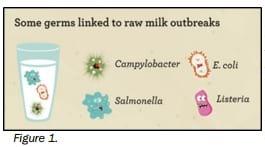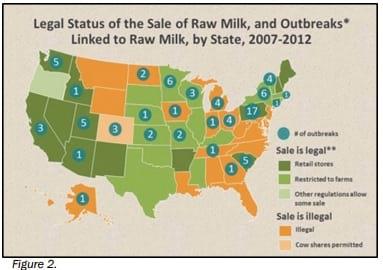How safe is the consumption of raw milk?
Published: July 20, 2017
By: Dr. Raúl A. Almeida and Stephen P. Oliver / University of Tennessee
Milk is one of Mother Nature’s most perfect foods; however, milk quality is jeopardized when it contains life-threatening pathogens. Through science-based knowledge, procedures have been developed to make milk safer for the consumer without losing its nutritional value. Pasteurization kills harmful bacteria by heating milk to a specific temperature for a set period, eliminating microorganisms responsible for diseases such as listeriosis, typhoid fever, tuberculosis, diphtheria, and brucellosis.
Unpasteurized raw milk may contain harmful microorganisms, and its consumption may cause diarrhea, stomach cramping, and vomiting, and in some cases kidney failure, paralysis, chronic disorders, and even death. Despite these consequences, many people choose to consume raw milk to improve their health and feed it to their loved ones, sometimes finding themselves in a hospital bed fighting for their lives from infections caused by ingesting harmful bacteria. Examples include Guillan-Barré syndrome, which causes paralysis, and hemolytic uremic syndrome, which results in kidney failure and stroke. Contrary to popular belief, raw milk is NOT healthier and more nutritious than pasteurized milk. Most of the nutritional benefits of drinking raw milk are available from pasteurized milk without the risk of life-threatening diseases associated with raw milk.
 Some foodborne pathogens, i.e., Listeria and Salmonella can be found in milk of infected cows. However, the main sources of contamination with other harmful germs (Fig. 1) include feces, milking equipment, cows’ skin, insects and rodents, and other environmental sites. Pasteurization is the only method to eliminate potential pathogens from contaminated raw milk, and since milk is an ideal medium for bacterial growth, manipulation and processing of pasteurized milk must be conducted under strict, hygienic conditions to prevent post-pasteurization contamination.
Some foodborne pathogens, i.e., Listeria and Salmonella can be found in milk of infected cows. However, the main sources of contamination with other harmful germs (Fig. 1) include feces, milking equipment, cows’ skin, insects and rodents, and other environmental sites. Pasteurization is the only method to eliminate potential pathogens from contaminated raw milk, and since milk is an ideal medium for bacterial growth, manipulation and processing of pasteurized milk must be conducted under strict, hygienic conditions to prevent post-pasteurization contamination.Even when a laboratory test shows no contaminants in a raw milk sample, the result is only applicable to the sample that was submitted for testing, as contaminations can still occur in other batches of milk on the same farm that had previously shown negative results. Also, raw milk from organic farms or grass-fed cows has the same risks of contamination simply because most of the foodborne pathogens originate from cows’ feces, regardless of how they are fed.
In a review conducted by the CDC, 26 states reported 81 outbreaks due to the consumption of raw milk between 2007 and 2012, causing 979 illnesses and 73 hospitalizations (Fig. 2). The percentage of these outbreaks increased from 2% (2007-2009) to 5% (2010-2012); 81% occurred in states where sale of raw milk is legal. Of these, 71% originated directly from the farm, 13% from licensed sellers, and 12% from cow-share programs.

A raw milk outbreak in one state can lead to outbreaks in neighboring states. For example, a 2011 outbreak in NC where sale of raw milk is illegal was traced back to a “buying club” in SC where sale is legal. Similarly, a 2012 Campylobacter outbreak in PA where raw milk sale is legal was linked to cases of foodborne illnesses in MD, WV, and NJ, where sale is illegal.
To conclude, an increasing number of people are consuming unpasteurized raw milk based on its unsubstantiated enhanced nutritional qualities, taste, and health benefits. This trend continues even though numerous studies have shown very clearly that raw milk can be contaminated by a variety of pathogens associated with human illness. Epidemiologic and outbreak data are clear: human diseases associated with consumption of raw milk are on the rise and are considerably higher than those from pasteurized milk. Given continued interest in the consumption of raw milk, efforts to educate policy makers/regulators/legislators on food safety hazards associated with consumption of raw milk are necessary so that appropriate microbial standards for raw milk can be established. One sure way to prevent raw milk-associated foodborne illness is for consumers to refrain from drinking unpasteurized milk.
This article was originally published in the Southeast Quality Milk Initiative Quarterly, Spring 2017.
Related topics:
Authors:
University of Tennessee (USA)
University of Tennessee (USA)
Recommend
Comment
Share
21 de junio de 2019
Raw milk is milk that has not been pasteurized to kill harmful bacteria. It can come from any animal. Raw milk can carry dangerous germs, such as Brucella, Campylobacter, Cryptosporidium, E. coli, Listeria, and Salmonella, which can pose serious health risks to you and your family.
Recommend
Reply
17 de junio de 2019
Drinking Raw milk has the higher risk for pregnant women, children, older adults and those with weakened immune systems.
Raw milk and raw milk products, including soft cheese, ice cream, and yogurt, can be contaminated with harmful bacteria and other germs that can cause serious illness, hospitalization, or death.
Recommend
Reply
Recommend
Reply
30 de abril de 2019
Pasterization can not be ignored as the effective way to render the milk safe for human consumption.
In the current day scenario, there are hundreds of unstudied sources of getting contamination into the clean milk drawn from a healthy udder.
Situation is of concern especially in developing countries.
Theory of raw milk curing certain ailments may not form the strong basis to prefer consuming raw milk, in my opinion.
Recommend
Reply
26 de julio de 2017
Dear colleagues. Hi, it is good topic, if the animal is free of above mentioned diseases the raw milk consumption could no be harmful but the milk that came out from nipple of the teats due to bad sanitation is hazardous for the health. Other point is the availability of antibiotic and it is residues in milk after treatment especially if the withdrawal period of antibiotic is longer, from health and economical point of views is not safer. Thanks, Dr. Abdul Qader Samsor, technical team leader in Animal husbandry project, Ministry of Agriculture and livestock.
Recommend
Reply
25 de julio de 2017
Well, consumption of raw milk wouldn't be hazardous provided the milk is harvested from healthy (i.e., disease free) animal and and handled under a very sanitary environment. It should be noted that if processed milk is not properly handled post after processing could be more life threatening if consumed the than the raw milk.
Recommend
Reply
25 de julio de 2017
It is a beautiful article for brain storming. Traditionally farmers prefer raw milk consumption but ill effects are not recorded and symptoms appear late and in different shape so consumer blames something else responsible for that disease instead of raw milk. Very practical approach and alternative left for is pasteurization only
Recommend
Reply
24 de julio de 2017
Dear Author,
Are these pathogens are coming from animal udder or environmentally born?
What is the safe time for use raw milk after milking?
Recommend
Reply
24 de julio de 2017
Then how is it far more people who drink raw milk are healing themselves from issues like Crohn's Disease, even Celiac Disease & other digestion related issues? As well as kids who have issues with drinking store bought milk, but thrive & gain weight from drinking raw milk? Or adults who are lactose intolerant & can't drink store bought milk or ice cream, but can consume raw milk & ice cream made from raw milk or slightly cooked, but not commercialized ice cream? There's surely a difference between the health benefits from raw milk & store bought pasteurized store bought milk, I know there's a taste difference.
Recommend
Reply

Would you like to discuss another topic? Create a new post to engage with experts in the community.












.jpg&w=3840&q=75)